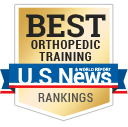Research, Data and Literature

Research Data:
2010. Hot off the Press! from the recent International Society for Hip Arthroscopy (ISHA) meeting at his Alma Mater, the Hospital for Special Surgery, we bring you the latest cutting edge information in Hip Arthroscopy. As the only Georgia member of the International Society for Hip Arthroscopy , Dr. Hyman wants to make sure the Atlanta community is 'in the loop' as well with emerging technologies.
In addition to treating labral tears, femoroacetabular impingement (FAI), loose bodies, synovitis, dislocations, cartilage damage and dysplasia, hip arthroscopy is now being used more readily for: greater trochanteric bursectomy, hip instability, adhesive capsulitis of the hip, release of external and internal snapping hip syndromes, and repairs of gluteus medius tears in the peritrochanteric space.
In isolated cases with limited pathology, bilateral hip arthroscopies are even being undertaken (traction time is limited).
Issues noted to be observed complications from around the world:
- transient Neurpraxias (nerve stretch)
- DVT (deep venous thrombosis)
- scuffing, scratching or gouging joint cartilage
- broken wires, shavers, beaver blade tips
- retained loose or foreign bodies,
- pressure necrosis of pinched skin
- numbness around genitalia, vaginal tearing, impotence
- unknown radiation effects
Very rare complications: infection, fracture, excessive fluid extravasation (leakage), dislocation after scope. Broken anchors, hemarthrosis, dissociated anchors or suture, or entrapped drains. Symptom exacerbation in about 5%.
Hip Arthroscopy may not be of advantage (or contraindicated) in some cases of obesity, excess stiffness, DJD / arthritis, when there's been extensive prior surgery, or in cases of Avascular necrosis (AVN).
Research Articles on Hip arthroscopy:
- Revision Hip Arthroscopy
- Hip Arthroscopy for Labral Tears
- Outcomes for FAI surgery with Hip Arthroscopy
Improvement Following Arthroscopic Hip Surgery: Marc J Philippon, MD Vail CO (a,g,e - Smith & Nephew, a - EBI, Genzyme) Patients felt improvement at 3 months following surgery; however, largest functional improvement was not seen until 7 months. This information is important for patient education so potential outcome can guide patient expectations. Hip arthroscopy often resulted in improved function and high patient satisfaction.
(Keep in mind this was a study of a "very mixed bag of patients," of all different ages, and doesn't describe what TYPE of arthroscopic surgery they had - there are many different types).
GOAL of the study: To determine patients' functional improvement over time during the first year following arthroscopic hip surgery.
Data was collected on 115 patients (65 females, 50 males) following arthroscopic hip surgery (3/2005-1/2006) with an average age of 40 (range 14-72). Patients completed subjective forms preoperatively (n=115), at 3 months (n=62), 5 months (n=22), 7 months (n=32), 9 months (n=31) and 12 months (n=18) postoperatively. Hip Outcome (HOS), Modified Harris Hip (MHH), Non-Arthritic Hip (NAH) and patient satisfaction (1=unsatisfied,10=very satisfied) scores were collected.
ADL HOS, MMH and NAH scores showed:
1. significant improvement at 3 months over preoperative scores (p<0.05).
2. significant improvement over pre-op at 7 months.
3. Largest functional improvement occurred between 5 and 7 months.
4. At 3 months 44% reported pain with walking, 50% at 5 months and 27% at 7 months. (1 in 4 patients still had pain with walking)
5. At 7 months 23% considered hip function abnormal; however only 16% considered their condition unchanged/worse at 3 months.
6. Average patient satisfaction at all time points was 8.0 (range 1-10).















